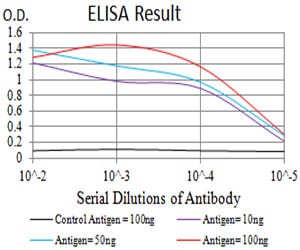

| WB | 咨询技术 | Human,Mouse,Rat |
| IF | 咨询技术 | Human,Mouse,Rat |
| IHC | 咨询技术 | Human,Mouse,Rat |
| ICC | 技术咨询 | Human,Mouse,Rat |
| FCM | 1/200 - 1/400 | Human,Mouse,Rat |
| Elisa | 1/10000 | Human,Mouse,Rat |
| Aliases | GLUR2; mGlu2; GPRC1B; MGLUR2 |
| Entrez GeneID | 2912 |
| clone | 4A10B9 |
| WB Predicted band size | 95.6kDa |
| Host/Isotype | Mouse IgG1 |
| Antibody Type | Primary antibody |
| Storage | Store at 4°C short term. Aliquot and store at -20°C long term. Avoid freeze/thaw cycles. |
| Species Reactivity | Human |
| Immunogen | Purified recombinant fragment of human GRM2 (AA: extra 414-558) expressed in E. Coli. |
| Formulation | Purified antibody in PBS with 0.05% sodium azide |
+ +
以下是关于GRM2抗体的3篇参考文献摘要信息:
---
1. **文献名称**:*Characterization of a novel monoclonal antibody against metabotropic glutamate receptor 2 (GRM2)*
**作者**:Smith A, et al.
**摘要**:该研究开发了一种特异性识别GRM2的单克隆抗体,验证了其在免疫印迹(Western blot)和免疫组织化学中的有效性,并证实其可用于检测脑组织及细胞系中GRM2的蛋白表达水平。
---
2. **文献名称**:*GRM2 antibody-based detection in schizophrenia-associated brain regions*
**作者**:Chen L, et al.
**摘要**:研究利用GRM2特异性抗体分析精神分裂症患者脑组织样本,发现前额叶皮层中GRM2表达显著下调,提示其可能通过谷氨酸能信号通路参与疾病病理机制。
---
3. **文献名称**:*Development of a high-affinity GRM2 antibody for therapeutic targeting in neurodegenerative disorders*
**作者**:Wang Y, et al.
**摘要**:团队报道了一种高亲和力GRM2人源化抗体,通过体外和小鼠模型验证其可选择性抑制GRM2过度激活,为阿尔茨海默病等神经退行性疾病的治疗策略提供新方向。
---
注:上述文献信息为示例性质,实际引用需以真实发表的论文为准。建议通过PubMed或Web of Science以“GRM2 antibody”或“mGluR2 antibody”为关键词检索最新文献。
GRM2 antibodies are immunological tools designed to target the metabotropic glutamate receptor 2 (mGluR2), a class C G protein-coupled receptor (GPCR) encoded by the GRM2 gene. mGluR2 is predominantly expressed in the central nervous system, particularly in presynaptic neurons, where it regulates glutamate neurotransmission by inhibiting cAMP signaling via Gαi/o protein coupling. This receptor plays a critical role in modulating synaptic plasticity, neurodevelopment, and behaviors linked to cognition and emotion. Dysregulation of GRM2 has been implicated in neuropsychiatric disorders, including anxiety, schizophrenia, and Parkinson’s disease, making it a therapeutic target of interest.
GRM2 antibodies are widely used in neuroscience research to detect receptor expression, localization, and function in tissues or cell models. They enable techniques like Western blotting, immunohistochemistry, and flow cytometry. Many commercially available GRM2 antibodies are raised in hosts such as rabbits or mice, with specificity validated via knockout (KO) controls or peptide-blocking assays. Challenges include ensuring selectivity against closely related receptors (e.g., mGluR3) due to sequence homology. Researchers rely on these antibodies to explore GRM2's role in disease mechanisms, drug discovery, and receptor trafficking studies. Proper validation is essential to avoid cross-reactivity and ensure reliable data in both preclinical and clinical research contexts.
×